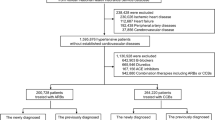Abstract
Reported findings of elevated risk of adverse events associated with calcium channel blocker use in hypertensives may be due partly to unmeasured confounding by indication. To determine if such confounding occurs, we conducted a retrospective cohort analysis of 77 196 Pennsylvania Medicaid recipients aged 18 to 61 who were treated with antihypertensive medication between 1990 and 1992. All diagnoses and dispensed prescriptions during the year prior to study entry were examined. Prior recipients of multitherapy (n = 18 763) were more likely to have had previously diagnosed risk factors (OR = 1.31 [95% CI, 1.30–1.33]) than subjects with prior monotherapy (n = 11141). New initiators (n = 47292) were less likely to have had previously diagnosed risk factors (OR = 0.48 (95% CI, 0.47–0.49)) than previous users (n = 29904). The likelihood of being prescribed calcium channel blocker rather than other monotherapy was significantly higher for subjects diagnosed during the previous week with arteriosclerotic cardiovascular disease OR = 7.78 (95% CI, 2.72–22.28), P < 0.0001; angina OR = 2.92 (95% CI, 1.77–4.83), (P < 0.0001); diabetes OR = 1.49 (95% CI, 1.07–2.06), (P = 0.0004); and hypertension OR = 1.57 (95% CI 1.35–1.82), (P < 0.0001). Calcium channel blockers were selectively prescribed to subjects at elevated risk of adverse events. Confounding by indication was found in this large indigent population. Unmeasured confounding may contribute to overestimated relative risk of adverse events associated with calcium channel blocker therapy vs diuretics or beta-blockers. At least 1 full year of subjects’ medical and prescription drug history should be examined prior to study entry; shorter observation periods will miss clinically relevant information about risk.
This is a preview of subscription content, access via your institution
Access options
Subscribe to this journal
Receive 12 digital issues and online access to articles
$119.00 per year
only $9.92 per issue
Buy this article
- Purchase on Springer Link
- Instant access to full article PDF
Prices may be subject to local taxes which are calculated during checkout
Similar content being viewed by others
Author information
Authors and Affiliations
Rights and permissions
About this article
Cite this article
Leader, S., Mallick, R. & Roht, L. Using medication history to measure confounding by indication in assessing calcium channel blockers and other antihypertensive therapy. J Hum Hypertens 15, 153–159 (2001). https://doi.org/10.1038/sj.jhh.1001155
Received:
Revised:
Accepted:
Published:
Issue Date:
DOI: https://doi.org/10.1038/sj.jhh.1001155



